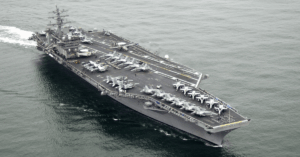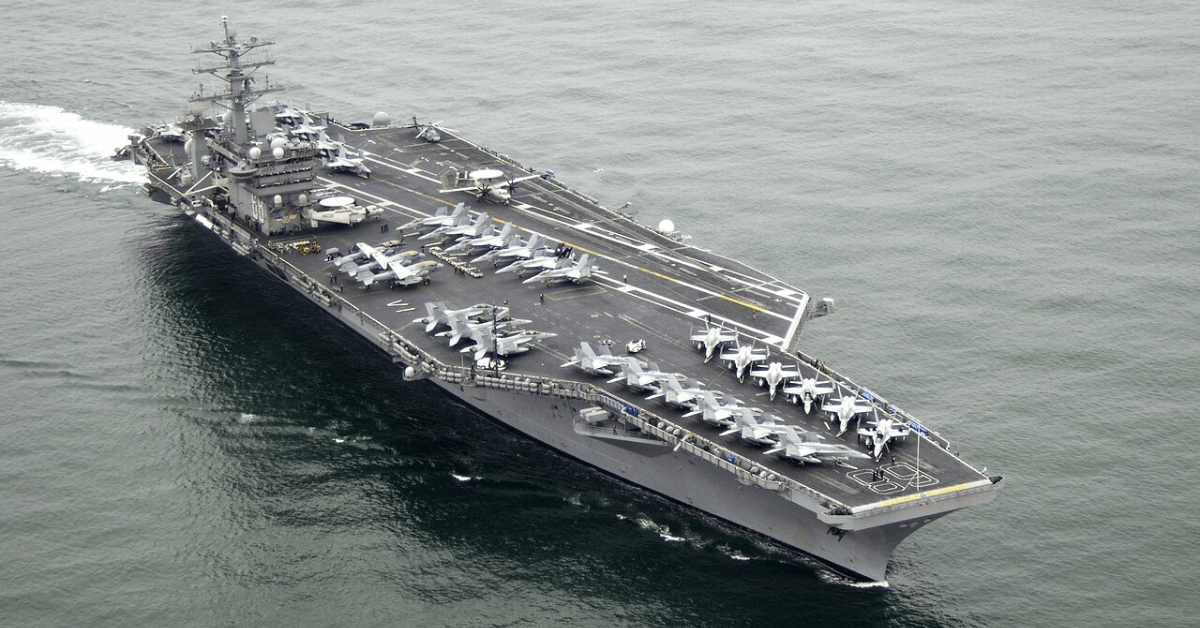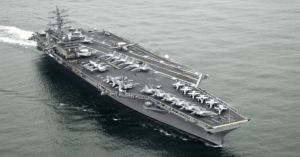
Video Shows Massive Fire Erupting From Oil Tankers After Collision
June 18, 2025
HD Hyundai Launches Hi-WING, Korea’s First Wing Sail For Ships
June 18, 2025

The U.S. Navy aircraft carrier USS Nimitz, which had been operating in the South China Sea, is now heading west to the Arabian Sea to join the USS Carl Vinson and its strike group already stationed there.
According to U.S. defense officials, the sudden deployment was not originally planned and is a strategic shift amid rising tensions between Israel and Iran.
The Nimitz, the oldest active aircraft carrier in the U.S. Navy, had been scheduled to relieve the Carl Vinson, but is now arriving early. Both carriers will operate in the region at the same time.
This may be the final voyage for the Nimitz, which is set to be decommissioned in 2026. The carrier was also deployed during the 1980 Operation Eagle Claw mission in Iran, which aimed to rescue U.S. hostages.
According to tracking data and reports from Marine Traffic, USS Nimitz left the South China Sea on Monday and sailed westward through the Strait of Malacca. A planned port visit to Da Nang City, Vietnam, set for June 20, was cancelled at the last minute.
One diplomat told Reuters that the U.S. Embassy in Hanoi informed him that the reception was cancelled due to an “emergent operational requirement.”
This comes as Israel continues launching strikes against Iran’s nuclear sites and top leaders. In response, Iran has been firing missiles and drones at Israeli targets. U.S. air defense systems, including Patriot and Terminal High Altitude Area Defense (THAAD), have helped intercept these attacks. A U.S. Navy destroyer also shot down Iranian ballistic missiles on Friday.
The USS Thomas Hudner, a Navy destroyer equipped with missile defense systems, has moved from the western to the eastern Mediterranean to get closer to the region.
Another destroyer is also being repositioned, making it ready for possible deployment based on decisions from the White House. Officials said the Navy might consider bringing in other carriers like USS George Washington, which just left its homeport in Japan, if needed.
U.S. fighter jets are currently flying missions across the Middle East to protect American forces and facilities. Defense officials also said that military bases in the region are tightening security.
The number of U.S. troops in the Middle East has now grown to about 40,000, up from the usual 30,000. It reached 43,000 at one point last October during another regional tension. That surge followed Hamas-led attacks on Israel on October 7, 2023, and the U.S. responded by deploying ships to deter groups like Hezbollah and Iran from escalating further.
The Pentagon has expanded deployments to the Middle East and Europe. Over two dozen U.S. tanker aircraft, KC-135 Stratotankers and KC-46 Pegasuses, left airfields across the United States on Sunday and Monday. They landed at bases in Spain, Germany, Greece, Italy, and Scotland. These tankers are critical for refuelling aircraft and preparing for any potential air operations.
A U.S. official familiar with the mission said this move was made to allow commanders more flexibility in case U.S. installations are directly threatened.
Secretary of Defense Pete Hegseth confirmed on Monday that he had ordered additional deployments to the Middle East. In a televised interview, he said the U.S. is prepared, acting defensively, and committed to protecting its people and assets.
Meanwhile, Israeli airstrikes on Iran began on June 13 while President Donald Trump was working on a deal aimed at limiting Iran’s nuclear activities. Since then, the strikes have widened to include Iranian military officials, state-run facilities, and even energy infrastructure.
Trump posted on social media, criticising Iranian leaders for rejecting a proposed deal and warned of possible escalation. He urged citizens to “immediately evacuate Tehran” and said U.S. forces might join Israel’s military campaign if necessary.
U.S. officials have said the military is not involved in Israel’s attacks, but American defense systems have been active, intercepting Iranian missiles and drones aimed at Israel.
During a press briefing, Israeli Prime Minister Benjamin Netanyahu claimed that American pilots were helping shoot down Iranian drones. He also said he speaks regularly with President Trump and did not rule out the possibility of targeting Iran’s Supreme Leader, Ayatollah Ali Khamenei.
The U.S. already has a strong military presence in the region. The aircraft carrier USS Carl Vinson, cruiser USS Princeton, and destroyers USS Sterett, USS Milius, and USS Wayne E. Meyer are operating in the Arabian Sea. The Red Sea is being patrolled by the destroyers USS Forrest Sherman and USS Truxtun, and the USS Canberra, a littoral combat ship, recently arrived in Bahrain.
In the Mediterranean, three more destroyers, USS Sullivans, USS Arleigh Burke, and USS Thomas Hudner, are patrolling the waters. The Thomas Hudner moved closer to Israel after last week’s Iranian attacks.
Further south in the Indian Ocean, the U.S. is using its strategic base on Diego Garcia, which is now playing a key role. Satellite images from May show six B-2 stealth bombers and four B-52 bombers stationed there.
These aircraft are capable of delivering the Massive Ordnance Penetrator-one of the most powerful non-nuclear bombs in existence, designed to hit underground nuclear targets.
Meanwhile, open-source analysts have reported that almost three dozen U.S. aerial refuelling tankers have flown to Europe, signalling preparations for a potential large-scale air campaign if needed.
References: foxnews, washingtonpost
Source: Maritime Shipping News


